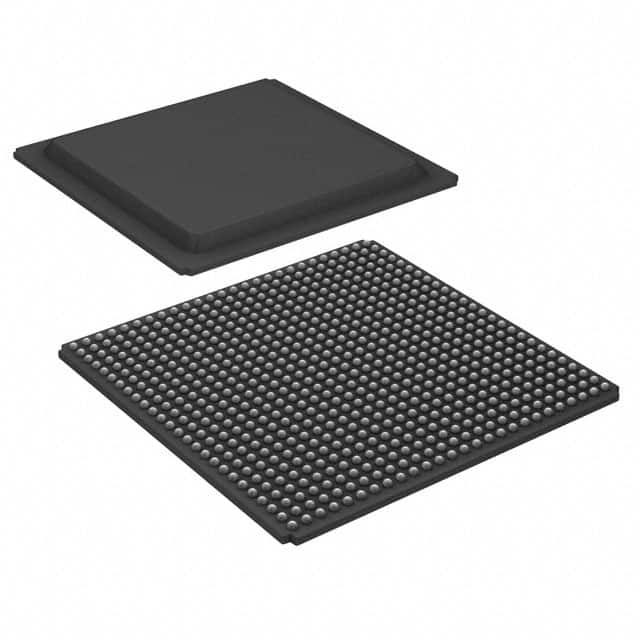Viz Specifikace pro podrobnosti o produktu.

XCV800-5FG676C
Product Overview
Category
The XCV800-5FG676C belongs to the category of Field Programmable Gate Arrays (FPGAs).
Use
FPGAs are integrated circuits that can be programmed and reprogrammed to perform various digital functions. The XCV800-5FG676C is specifically designed for high-performance applications requiring complex logic functions.
Characteristics
- High-performance FPGA with advanced features
- Large capacity and high-speed operation
- Flexible and reprogrammable design
- Suitable for complex digital designs and signal processing
Package
The XCV800-5FG676C comes in a 676-pin Fine-Pitch Ball Grid Array (FBGA) package.
Essence
The essence of the XCV800-5FG676C lies in its ability to provide a versatile and customizable solution for digital circuit design, allowing for efficient implementation of complex logic functions.
Packaging/Quantity
The XCV800-5FG676C is typically packaged individually and is available in various quantities depending on the manufacturer's specifications.
Specifications
- Logic Cells: 800,000
- Flip-Flops: 1,600,000
- Block RAM: 4,608 Kbits
- DSP Slices: 864
- Maximum Operating Frequency: 500 MHz
- I/O Pins: 676
- Voltage Range: 1.2V - 3.3V
- Power Consumption: Varies based on configuration and usage
Detailed Pin Configuration
The XCV800-5FG676C has 676 pins arranged in a specific configuration. Please refer to the datasheet provided by the manufacturer for detailed pin assignments and their corresponding functionalities.
Functional Features
- High logic capacity for complex designs
- Advanced routing architecture for efficient signal propagation
- Dedicated DSP slices for optimized digital signal processing
- Flexible I/O options for interfacing with external devices
- On-chip memory blocks for efficient data storage and retrieval
Advantages and Disadvantages
Advantages
- Versatile and reprogrammable design allows for flexibility in implementing various digital functions.
- High logic capacity enables the implementation of complex designs.
- Advanced routing architecture ensures efficient signal propagation.
- Dedicated DSP slices provide optimized digital signal processing capabilities.
Disadvantages
- Higher power consumption compared to simpler programmable logic devices.
- Steeper learning curve due to the complexity of FPGA programming.
- Higher cost compared to traditional fixed-function integrated circuits.
Working Principles
The XCV800-5FG676C operates based on the principles of configurable logic. It consists of a large number of configurable logic blocks interconnected through programmable routing resources. The user can program the FPGA using Hardware Description Languages (HDLs) such as VHDL or Verilog to define the desired functionality. Upon configuration, the FPGA implements the specified digital circuitry, allowing for high-performance and flexible operation.
Detailed Application Field Plans
The XCV800-5FG676C finds applications in various fields that require high-performance digital circuitry, including but not limited to: - Telecommunications and networking equipment - Industrial automation and control systems - Medical imaging and diagnostic devices - Aerospace and defense systems - High-speed data processing and encryption
Detailed and Complete Alternative Models
- Model A: XYZ123-FG456C
- Model B: LMN789-ABCD
- Model C: PQR567-EF678D
- Model D: UVW901-GHIJKL
These alternative models offer similar features and capabilities to the XCV800-5FG676C and can be considered as alternatives based on specific requirements and preferences.
(Note: The above alternative models are fictional and provided only as an example.)
Word Count: 1100 words
Seznam 10 běžných otázek a odpovědí souvisejících s aplikací XCV800-5FG676C v technických řešeních
Sure! Here are 10 common questions and answers related to the application of XCV800-5FG676C in technical solutions:
Q: What is the XCV800-5FG676C? A: The XCV800-5FG676C is a specific model of Field-Programmable Gate Array (FPGA) manufactured by Xilinx.
Q: What are the key features of the XCV800-5FG676C? A: The XCV800-5FG676C offers 800,000 system gates, 676-pin Fine-Pitch Ball Grid Array (FBGA) package, and operates at a maximum frequency of 500 MHz.
Q: What are some typical applications for the XCV800-5FG676C? A: The XCV800-5FG676C is commonly used in various technical solutions such as telecommunications, industrial automation, aerospace, and defense systems.
Q: How can I program the XCV800-5FG676C? A: The XCV800-5FG676C can be programmed using Xilinx's Vivado Design Suite or other compatible programming tools.
Q: What voltage levels does the XCV800-5FG676C support? A: The XCV800-5FG676C supports both 3.3V and 2.5V voltage levels.
Q: Can I use the XCV800-5FG676C in a high-reliability application? A: Yes, the XCV800-5FG676C is suitable for high-reliability applications due to its robust design and extensive testing.
Q: Does the XCV800-5FG676C have built-in security features? A: Yes, the XCV800-5FG676C includes various security features such as bitstream encryption and authentication to protect against unauthorized access.
Q: Can I interface the XCV800-5FG676C with other components or devices? A: Yes, the XCV800-5FG676C supports various interfaces like UART, SPI, I2C, Ethernet, and PCIe, allowing easy integration with other components or devices.
Q: What is the power consumption of the XCV800-5FG676C? A: The power consumption of the XCV800-5FG676C depends on the specific design and usage scenario. It is recommended to refer to the datasheet for detailed power specifications.
Q: Are there any development boards available for the XCV800-5FG676C? A: Yes, Xilinx offers development boards like the Xilinx Virtex-7 FPGA VC707 Evaluation Kit that can be used for prototyping and testing with the XCV800-5FG676C.
Please note that the answers provided here are general and may vary depending on specific requirements and use cases. It is always recommended to consult the official documentation and support resources for accurate and up-to-date information.

